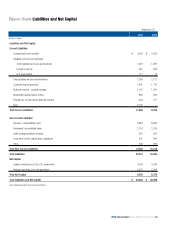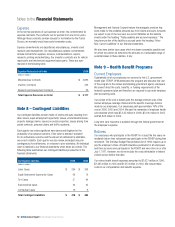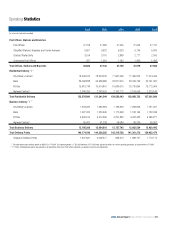US Postal Service 2006 Annual Report Download - page 51
Download and view the complete annual report
Please find page 51 of the 2006 US Postal Service annual report below. You can navigate through the pages in the report by either clicking on the pages listed below, or by using the keyword search tool below to find specific information within the annual report.2006 Annual Report United States Postal Service | 49
Cash - Restricted
We maintain a restricted cash account in conformity with statutes set forth
in P.L.108-18 to set aside “savings” See Note 10, Retirement Programs for
additional information. Restricted cash is reported as a non-current asset.
Allowance for Doubtful Accounts
We provide an allowance for doubtful accounts on our outstanding
receivables based on our collection history and an estimate of uncol-
lectible accounts. In 2005 we re-evaluated our allowance for doubtful
accounts methodology, based on our last five years of collection history.
This change in estimate reduced our allowance from $111 million in 2004,
to $50 million at the end of 2005. In 2006 our allowance was $48 million.
Supplies Inventory
Our inventory is comprised of motor vehicle repair parts and repair parts
for mail processing equipment. We value our inventories at the lower of
average cost or market price. Total inventories amounted to $125 million
at the end of 2006 and $119 million at the end of 2005.
Property and Equipment
We record property and equipment at cost, including the interest we
pay on the money we borrow to pay for the construction of major capital
additions. See Note 5, Property and Equipment for additional information.
We depreciate buildings and equipment over their estimated useful lives,
which range from 3 to 40 years, except buildings with historic status
which are depreciated over 75 years, using the straight-line method.
Impaired Assets
We record losses on long-lived assets when events and circumstances
indicate that the assets might be impaired. In accordance with Financial
Accounting Standards Board (FASB) Statement 144, Accounting for
the Impairment or Disposal of Long-Lived Assets, we write down our
impaired assets to the lower of cost or fair value. See Note 5, Property and
Equipment for additional information.
Asset Retirement Obligations
We account for our asset retirement obligations in accordance with
Financial Accounting Standards Board Interpretation 47, Accounting for
Conditional Asset Removal (FIN 47).
In March 2005, the FASB issued FIN 47, which requires a liability to be
accrued if the reporting entity has a legal obligation to perform asset
retirement activities and a reasonable estimate of the fair market value of
the obligation can be made at year-end. FIN 47 also provides guidance as
to when an entity would have sufficient information to reasonably estimate
the fair value of an asset retirement obligation. We adopted the provisions
of FIN 47 effective October 1, 2005. The adoption of FIN 47 had no effect
on our financial statements.
Amortization of Leasehold Improvements
We amortize leasehold improvements over the period of the lease or the
useful life of the improvement, whichever is shorter.
Leasehold improvements that are placed in service significantly after the
start of the lease term are amortized over the shorter of the useful life of
the asset or the lease term including expected renewal options.
Foreign Currency Translation
We have foreign currency risk related to the settlement of terminal dues
and transit fees with foreign postal administrations for international mail.
The majority of our international accounts are denominated in special
drawing rights (SDRs). The SDR exchange rate fluctuates daily based on a
basket of currencies comprised of the euro, Japanese yen, pound sterling
and the U.S. dollar. Changes in the relative value of these currencies will
increase or decrease the value of our settlement accounts and result in a
gain or loss from revaluation reported in the results from operations. The
actual currency used to settle accounts varies by country. See Note 6,
Foreign Currency Translation for additional information.
Outstanding Postal Money Orders
We sell money orders to the general public at our retail locations. We
charge a fee to the customer at the time of sale. The fee is recognized as
revenue at the time of sale. We recognize a liability for money orders we
expect to be presented for payment.
Valuation of Debt Instruments
The current value of our debt is what it would cost to pay off the debt if we
used the current yield on equivalent U.S. Treasury notes.
Revenue Recognition/Deferred Revenue-Prepaid
Postage
We recognize revenue when service is rendered. Deferred revenue-pre-
paid postage is the amount of cash we estimate that we collected by the
end of the year for services that we will perform in the following year.
Advertising Expenses
Advertising costs are expensed as incurred and are classified in other
operating expenses. Advertising expenses were $138 million in 2006,
$143 million in 2005 and $108 million in 2004.
Compensation and Benefits Payable
This is the salaries and benefits we owe to current and retired employees,
including the amounts employees have earned but have not yet been paid,
current workers’ compensation, unemployment costs and health benefits.
Workers’ Compensation
We pay for workers’ compensation costs under a program administered by
the Department of Labor (DOL). These costs include employees’ medical
expenses, payments for continuation of wages and DOL administrative
fees. We record these costs as an operating expense. See Note 11,
Workers Compensation for additional information.
Notes to the Financial Statements
























